
High School Ecology

An alternative introduction to the chapter "Adapting and Living Together" - explained with Vamipres! It sits within the Ecology and Environment topic of the virtual school GCSE Biology. Teachers can choose which engagement video is better for their own uses and students.
- Material Type:
- Full Course
- Lecture
- Syllabus
- Date Added:
- 02/21/2013
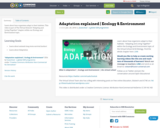
Learn about how organisms adapt to their habitats. This video is part of The Virtual School's "Adapting and Living Together" chapter within our Ecology and Environment topic.
- Material Type:
- Diagram/Illustration
- Full Course
- Lecture
- Syllabus
- Date Added:
- 02/21/2013
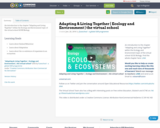
An introduction to the chapter "Adapting and Living Together" within the Ecology and Environment topic of the virtual school GCSE Biology.
- Material Type:
- Diagram/Illustration
- Lecture
- Syllabus
- Unit of Study
- Date Added:
- 02/21/2013

Study of the most common advanced optimisation models in engineering problems, both Industrial and Telecommunication.
- Material Type:
- Full Course
- Date Added:
- 03/16/2015

How do animals communicate in the environment? And how does this affect their behaviour? Learn about animal communication in this GCSE / K12 Ecology video from the Virtual School.
Are you a passionate teacher who would like to reach tens of thousands of learners?
Get in touch: vsteam@fusion-universal.com
Find out more: http://www.thevirtualschool.com
Follow us: http://www.youtube.com/virtualschooluk
Friend us: http://www.facebook.com/virtualschooluk
Teach the world.
This video is distributed under a Creative Commons License:
Attribution-NonCommercial-NoDerivs
CC BY-NC-ND
- Material Type:
- Diagram/Illustration
- Lecture
- Date Added:
- 03/18/2013
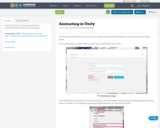
A short tutorial on creating an animated two-dimensional sprite in the Unity game engine.
- Material Type:
- Diagram/Illustration
- Date Added:
- 12/04/2015
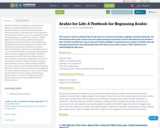
Arabic for Life takes an intensive, comprehensive approach to beginning Arabic instruction and is specifically tailored to the needs of talented and dedicated students. Unlike the other Arabic textbooks on the market, Arabic for Life is not specifically focused on either grammar or proficiency. Instead, it offers a balanced methodology that combines these goals. Frangieh has created a book that is full of energy and excitement about Arabic language and culture, and it effectively transmits that excitement to students. Arabic for Life offers a dynamic and multidimensional view of the Arab world that incorporates language with Arabic culture and intellectual thought.
The book is accompanied by a DVD with some eighty videos of native speakers reciting the vocalized texts in the book and dozens of audio recordings covering vocabulary and expressions, drills on Arabic sounds and letters, and various exercises and activities.
Bassam Frangieh is professor of Arabic at Claremont-McKenna College. He previously taught at Georgetown, Yale, and the Foreign Service Institute. He is the author of Anthology of Arabic Literature, Culture, and Thought from Pre-Islamic Times to the Present, published by Yale University Press.
- Material Type:
- Activity/Lab
- Textbook
- Date Added:
- 01/30/2013
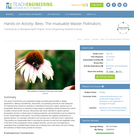
The study of biomimicry and sustainable design promises great benefits in design applications, offering cost-effective, resourceful, non-polluting avenues for new enterprise. An important final caveat for students to understand is that once copied, species are not expendable. Biomimicry is intended to help people by identifying natural functions from which to pattern human-driven services. Biomimicry was never intended to replace species. Ecosystems remain in critical need of ongoing protection and biodiversity must be preserved for the overall health of the planet. This activity addresses the negative ramifications of species decline. For example, pollinators such as bees are a vital work force in agriculture. They perform an irreplaceable task in ensuring the harvest of most fruit and vegetable crops. In the face of the unexplained colony collapse disorder, we are only now beginning to understand how invaluable these insects are in keeping food costs down and even making the existence of these foods possible for humans.
- Subject:
- Applied Science
- Ecology
- Engineering
- Life Science
- Material Type:
- Activity/Lab
- Provider:
- TeachEngineering
- Provider Set:
- TeachEngineering
- Author:
- Amber Spolarich
- Wendy J. Holmgren
- Date Added:
- 09/18/2014

With a continued focus on the Sonoran Desert, students are introduced to the concepts of biomes, limiting factors (resources), carrying capacity and growth curves through a PowerPoint® presentation. Abiotic factors (temperature, annual precipitation, seasons, etc.) determine the biome landscape. The vegetative component, as producers, determines the types of consumers that form its various communities. Students learn how the type and quantity of available resources defines how many organisms can be supported within the community, as well as its particular resident species. Students use mathematical models of natural relationships (in this case, sigmoid and exponential growth curves) to analyze population information and build upon it. With this understanding, students are able to explain how carrying capacity is determined by the limiting factors within the community and feeding relationships. By studying these ecological relationships, students see the connection between ecological relationships of organisms and the fundamentals of engineering design, adding to their base of knowledge towards solving the grand challenge posed in this unit.
- Subject:
- Applied Science
- Ecology
- Engineering
- Life Science
- Material Type:
- Lesson Plan
- Provider:
- TeachEngineering
- Provider Set:
- TeachEngineering
- Author:
- Amber Spolarich
- Wendy J. Holmgren
- Date Added:
- 09/18/2014
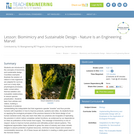
Students are introduced to the concepts of biomimicry and sustainable design. Countless examples illustrate the wisdom of nature in how organisms are adapted for survival, such as in body style, physiological processes, water conservation, thermal radiation and mutualistic relationships, to assure species perpetuation. Students learn from articles and videos, building a framework of evidence substantiating the indisputable fact that organisms operate "smarter" and thus provide humans with inspiration in how to improve products, systems and cities. As students focus on applying the ecological principles of the previous lessons to the future design of our human-centered world, they also learn that often our practices are incapable of replicating the precision in which nature completes certain functions, as evidenced by our dependence on bees as pollinators of the human food supply. The message of biomimicry is one of respect: study to improve human practices and ultimately protect natural systems. This heightened appreciation helps students to grasp the value of industry and urban mimetic designs to assure protection of global resources, minimize human impact and conserve nonrenewable resources. All of these issues aid students in creating a viable guest resort in the Sonoran Desert.
- Subject:
- Applied Science
- Ecology
- Engineering
- Forestry and Agriculture
- Geoscience
- Life Science
- Physical Science
- Material Type:
- Lesson Plan
- Provider:
- TeachEngineering
- Provider Set:
- TeachEngineering
- Author:
- Wendy J. Holmgren
- Date Added:
- 09/18/2014
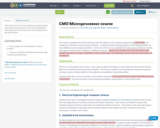
This course serves as an introduction to programming and using microprocessors. It also provides students with experiences where they can create solutions for a specific problem.
- Material Type:
- Unit of Study
- Date Added:
- 02/26/2013
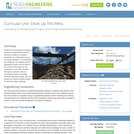
Students are challenged to design a method for separating steel from aluminum based on magnetic properties as is frequently done in recycling operations. To complicate the challenge, the magnet used to separate the steel must be able to be switched off to allow for the recollection of the steel. Students must ultimately design, test, and present an effective electromagnet.
- Subject:
- Applied Science
- Ecology
- Engineering
- Forestry and Agriculture
- Life Science
- Physical Science
- Physics
- Technology
- Material Type:
- Unit of Study
- Provider:
- TeachEngineering
- Provider Set:
- TeachEngineering
- Author:
- Justin Montenegro
- Date Added:
- 09/18/2014

Schrauben lösen, Kabel neu verlegen: Messer, Gabel und Pudelmütze werden zum Input für den Computer. Ziel ist es, neue Benutzerschnittstellen für den Computer zu entwickeln, indem die TeilnehmerInnen einen Blick "unter die Motorhaube" einer USB-Tastatur werfen. So können Jugendliche im Alter von 13 - 17 Jahren erste Schritte im kreativen Umgang mit Elektronik machen und dabei viel Spaß haben.
Voraussetzungen sind lediglich die Freude am Experimentieren und die Neugier, technologische Grundlagen spielerisch zu erlernen.
- Material Type:
- Activity/Lab
- Diagram/Illustration
- Game
- Lesson Plan
- Date Added:
- 10/22/2014
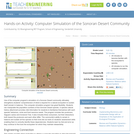
The computer program's simulation of a Sonoran desert community should ultimately strengthen the student's comprehension of what is required for a natural ecosystem to sustain itself (remain in balance). This computer simulation program has great flexibility. It allows the student to manipulate the population numbers of five Sonoran Desert species. A species natural history attachment provides vital information for the students to familiarize themselves with each species' behaviors, its niche and food resource needs. The program includes two producers, the Saguaro cactus and the Ironwood Tree. It also includes 3 consumers, but their interactions both toward the producers and each other differ. The community's ability to remain in balance and sustain all five species so that none die out rests on the student's assessment skills enabling him to correctly identify these dependencies. The student learns by trial and error as he continues to fine tune the ecosystem that he maintains stewardship of.
- Subject:
- Applied Science
- Ecology
- Engineering
- Life Science
- Material Type:
- Activity/Lab
- Provider:
- TeachEngineering
- Provider Set:
- TeachEngineering
- Author:
- Amber Spolarich
- Wendy J. Holmgren
- Date Added:
- 09/18/2014

This introductory class of computer skills is comprised of units that focus on basic computer hardware and the following applications: Word 2010, Excel 2010, PowerPoint 2010, Photo Gallery, and Audacity. Most units begin with YouTube overviews or 'how to' presentations followed by step by step guides to using aspects of the application and then have assessment exercises and conclude with a final project for evaluation.
- Material Type:
- Assessment
- Full Course
- Lecture
- Date Added:
- 09/25/2013
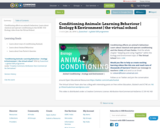
Conditioning affects an animal's behaviour. Learn about classical and operant conditioning in this GCSE / K12 Ecology video from the Virtual School.

A two-day assignment focusing in the melting or Arctic sea ice and the increased global temperature. The lesson involves reading the text Decline in Arctic Sea Ice, reviewing video clips, in depth discussions, and independent research and writing.
- Material Type:
- Lesson Plan
- Primary Source
- Date Added:
- 04/08/2015
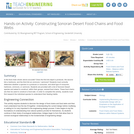
Is the food chain shown above accurate? Does the first link depict a producer, the second link a herbivore, and the third link an omnivore / carnivore? Students must correctly determine whether a species is a producer or consumer, and what type of consumer; herbivore, omnivore, or carnivore. Students are provided with a list of Sonoran Desert species and asked to construct, within their groups, several food chains. These food chains are then be used to construct a food web. In order to complete this activity, students must first research the individual species to understand their feeding habits.
- Subject:
- Applied Science
- Ecology
- Engineering
- Life Science
- Material Type:
- Activity/Lab
- Provider:
- TeachEngineering
- Provider Set:
- TeachEngineering
- Author:
- Amber Spolarich
- Wendy J. Holmgren
- Date Added:
- 09/18/2014

In an effort to raise awareness of astronomical developments, I have students search newspapers or online for any recent astronomical-related story and provide a photo and a short summary of the article including why they think it is important and I ask them to identify specially which chapter of the textbook deals with their story. I do this early in the semester as a way of getting students to become more familiar with the textbook and to try to get them to become lifelong learners and be in the habit of looking for current events related to astronomy.
- Material Type:
- Homework/Assignment
- Teaching/Learning Strategy
- Date Added:
- 10/09/2013
